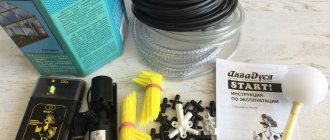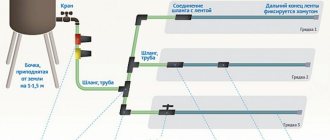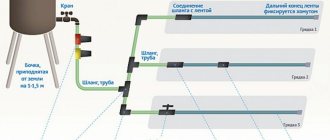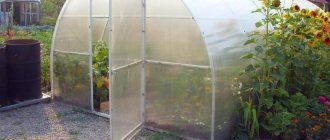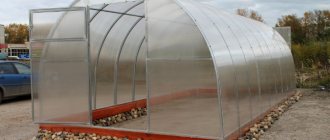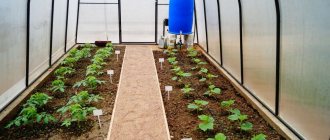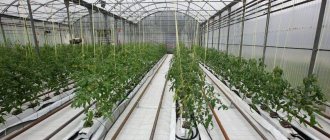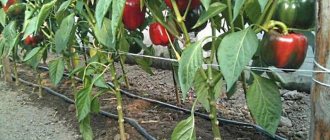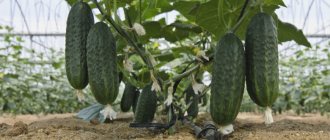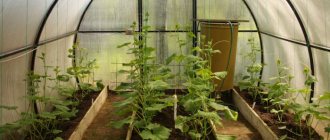A greenhouse is a frame structure, usually made of a metal profile, covered with a transparent, lightweight and durable material. The greenhouse maintains a certain microclimate necessary for growing the plants inside it. To obtain the result in the form of grown fruits, you need to put in a lot of time and physical effort, implementing a set of agrotechnical measures.
A smart greenhouse will make work easier, in which all the actions necessary for growing plants are carried out according to a program that controls special devices with virtually no human intervention.
The operating principle of a smart greenhouse
The diagram below of how a smart greenhouse works shows the extent of human participation in its functionality. User input is limited to software adjustments and direct setting of controller parameters. The adjustment can be carried out remotely through, for example, a computer connected to the controller.
The automatic operating mode is provided by sensors and a controller with electronic control circuits, which ensure the operation of the actuators in the required mode.
Which countries are using the technology?
America was the legislator of this trend - now they are very actively developing the Internet of things in agriculture: they use drones for sowing, they use tractors and combines that work according to coordinates without human intervention. Europe has also been developing in this direction over the past 10 years. For example, they are already picking strawberries there with the help of robots. Agricultural equipment is often more efficient and convenient than humans: it does not require days off, it is easier to operate, and it can work around the clock.
“In Russia, the Internet of Things in agriculture is used in the Krasnodar Territory, Astrakhan Region, and St. Petersburg. Almost all agricultural regions are on the verge of being used. Having seen the efficiency with which this works in the West, our specialists also began to introduce new technologies. Domestic developments in this area are also appearing.”
Classification of smart greenhouses
Any system in which any action is performed must have external energy sources for this. According to the method of using such energy, smart greenhouses can be classified into the following groups:
- autonomous - uses natural sources of thermal energy, for example solar;
- dependent on industrial energy sources - power is supplied from the electrical network.
The disadvantage of an autonomous system is the inertia of the automatic system, which, due to untimely operation of the actuators, does not guarantee the normal functioning of plants.
Energy-dependent operating systems of a smart greenhouse may have an emergency shutdown, which will have the worst consequences for the plants.
Based on the design and purpose of greenhouse complex devices, the following categories can be distinguished.
- Greenhouse. This is a room for growing exotic plants for which the climate of the area is not suitable. Usually covered with glass and used for scientific purposes to study the development of unusual plants.
- Greenhouse. These are premises for year-round cultivation of vegetables, berries and seedlings. Covered with a lightweight transparent material such as polycarbonate. The main goal of greenhouses is to obtain a high yield of vegetables and berries in a short agrotechnical time frame, regardless of the surrounding weather conditions.
- Greenhouse. The main purpose of a greenhouse is to grow seedlings. Usually this is a small portable structure covered with an easily rolled transparent film. The heat in it is created by natural energy sources.
Basic features of a smart greenhouse
The following types of work from the complex of mandatory agrotechnical measures carried out with plants in a greenhouse are subject to automation.
- Regulating the temperature preferred for growing plants in that particular greenhouse. Control over maintaining a given thermal regime.
- Creation of certain indicators of air humidity in the greenhouse. This indicator has a significant impact on the yield of some crops.
- Maintaining soil moisture within specified limits. The root system of plants should not dry out, and at the same time, excess moisture leads to plant disease.
- The organization of additional lighting in the greenhouse at any time of the year will ensure full growth of plants.
Benefits of Automation
The use of an automatic system for greenhouses makes it possible to significantly facilitate work on your garden plot and increase productivity up to several times. By installing an automatic machine for a greenhouse with your own hands, it is possible to create favorable conditions for the development and growth of plants without human intervention.
Autonomous irrigation systems will save time spent on watering, especially in summer cottages, when watering is required even on weekdays. The amount of water and fertilizer consumed is also significantly reduced. Lighting and heat heating allow you all year round .
Now you know everything about automating greenhouses with your own hands. By installing a greenhouse control system, labor costs are reduced several times, which means that a garden plot is not only a place for physical work, but also a place where you can enjoy relaxation and unity with nature!
Where can I buy
You can purchase equipment for smart greenhouses either in a specialized store or online in an online store. In the second case, the budget option for purchasing products on the Aliexpress website deserves special attention. For some products there is an option for shipment from a warehouse in the Russian Federation; they can be received as quickly as possible; to do this, when ordering, select “Delivery from the Russian Federation”:
| Automatic drive for opening Tuya window | Irrigation system with timer | Automatic watering kit for greenhouses with timer |
| Universal smart solution for remote monitoring of a greenhouse | LED grow light 1000/1500W | Smart lamp for plants with remote control |
Internet of Things in our daily life
This concept of a completely interconnected world. “Smart devices” can communicate with each other, exchange data and solve certain problems.
The Internet of Things appeared in early 2000 in America, spread to Europe and finally came to us. The simplest example is the Yandex traffic jams service. The server collects data on vehicle movement and posts it on the Internet on Yandex Maps. Now we can talk about smart robots that roll around the apartment and remove garbage, smart heated floors, etc.
It may seem that the “Internet of Things” sounds somehow un-Russian, but, unfortunately, there is no more adequate analogue to this concept in our language.
Sensors as the basis of information for a smart greenhouse
The following types of sensors, integrated in a digital format to transmit a signal to the controller, transmit time-varying parameters to the smart greenhouse control unit:
- air temperature sensors
- air humidity sensors
- soil temperature sensor
- soil moisture sensor
- light sensor
In addition to the sensors presented above, there are many others that some agricultural producers use in their activities: dew point sensors, soil chemical composition sensors, irrigation water quality control sensors and others.
We recommend reading: how to make a soil moisture sensor for an irrigation system with your own hands.
Software part
Everything is clear with the equipment. It remains to deal with the programs that manage it and control the state of the entire system. Since the complex contains two highly intelligent devices - ESS8266 and Arduino itself. Accordingly, both need their own programs. Placing them in the device memory, in both cases, is done through the Arduino IDE.
Monitoring
A sketch that needs to be uploaded to the ESP8266 LoLin NodeMCU to ensure its communication with the Arduino and WiFi router.
Control
And finally, a large sketch of controlling the greenhouse itself, which is uploaded to Arduino.
Design Notes
It is advisable to replace the DN11 sensor with a DN22, which, although more expensive, is more accurate and functions without the problems inherent in its younger namesake. To power the control circuits, you can use a computer power supply, preferably an AT form factor.
We recommend reading: follow the link if you want to learn how to connect a soil moisture sensor to Arduino.
Controller
The controller processes information and gives commands for the actions of actuators. This is a programmable electronic device that, according to a given algorithm, ensures the implementation of all agrotechnical tasks for caring for plants.
In addition to the electronic circuit itself and a set of sensors, the delivery package includes control and visualization programs.
As an example, we give the functionality of one type of Russian-made controller:
- control according to a program designed to operate throughout the day, where the initial data are the values of temperature and humidity;
- the position of the thermal drive for opening the vents is regulated by an algorithm for finding its most effective position for solving the task;
- finds optimal cooling options during critically high summer temperatures;
- performs micro-ventilation mode while maintaining optimal humidity;
- organizes automatic watering in the greenhouse with the addition of water to the tank and control of the supply to the plants together with the supply of the nutrient solution;
- participates in the preparation of the nutrient solution, controlling its composition;
- controls the heating system based on sensor readings;
- performs calculations of solar energy received by plants in a certain period of time;
- controls humidity simultaneously in several zones;
- operates with temperature data at several specified points in the greenhouse.
This set of functions qualitatively improves the conditions for growing plants in a greenhouse.
General information about control systems
The intelligence of modern equipment is provided by microcontrollers. These are small and resource-constrained full-format computers, often located on a single board or chip. Despite their small size, their power is quite sufficient to control various equipment. Such microcomputers obtain the information necessary to perform their functions through various specialized sensors. The general location of devices in a single network is ensured through additional modules attached to the microcontroller.
Carrying out their program, intelligent devices issue control pulses to executing circuits including motors, pumps, heaters or any other devices to control which the entire system is created.
The basis of many of these complexes are controllers of the Arduino, STM, Ti MSP430, Netduino, Teensy, Particle Photon, ESP8266 series or other common boards of this type in the world. In addition, some specialists create their own versions of micro-computers that control equipment based on outdated PCs or some 8-bit processors, for example, the Z80.
Market overview of industrial manufacturers of smart greenhouses
The market for smart greenhouses is becoming increasingly resilient. This is facilitated by the development of the following technologies:
- application of additional lighting technology based on light-emitting diodes (LED technology);
- in addition to wired, wireless communication is used for connection;
- improvement of irrigation system designs;
- improvement of technical characteristics of pumps and valves;
- an increase in the number of factors that indicate the occurrence of an emergency situation during its monitoring;
- application of advanced achievements in the field of IT technologies.
Rated manufacturers of smart greenhouses offer their products depending on the size of the greenhouse complex; technical solutions are selected in accordance with the type of crops grown.
On an industrial scale, smart greenhouses are used in northern latitudes. Vegetables and fruits that are exotic for the northern regions and grown in smart greenhouses will be much cheaper than those imported from the southern regions.
The intelligent segment of agriculture in the form of smart greenhouses will develop at a rapid pace thanks to domestic manufacturers. The government's focus on the digital economy will contribute to this.
The Netherlands and some other European countries are at the forefront of developing controlled environment agriculture technologies. The implementation of smart greenhouses is developing at an accelerated pace in India, Japan, and China.
Dominant positions in the smart greenhouse market are occupied by Rough Brothers (USA), Heliospectra (Sweden), GreenTech Agro (Netherlands) and others.
DIY smart greenhouses
It is too expensive for a simple summer resident to invest in a ready-made automated greenhouse. However, you can take advantage of its benefits by making it yourself.
We recommend that you familiarize yourself with how to make a smart greenhouse using Arduino with your own hands, it will allow you to save money and customize the system the way you need.
Features of the design and location on the site
For effective operation of automation systems, the following recommendations should be followed.
- Choose a place on the site where, according to the geography of the area, the maximum flow of sunlight will penetrate through the transparent film. This will reduce the load on additional LED lighting and reduce the cost of maintaining the greenhouse.
- Design the greenhouse frame so that the vents are located in the upper part of the greenhouse. Cold air, entering the greenhouse through the window, will slowly fall down, and warm air will also gradually rise up. This arrangement of the vents eliminates the formation of drafts that are harmful to the development of plants. Sealing the film and tightly closing the doors will eliminate the influence of external weather conditions on the microclimate of the greenhouse.
- If the site is located in an area with high wind conditions, then protection should be performed in the direction of the dominant wind direction, for example, covering the greenhouse with a hedge.
- For year-round use of the greenhouse, equip it with heating devices that will automatically turn on/off using specially configured temperature sensors.
Do-it-yourself automatic ventilation
Air circulation in the greenhouse is ensured by opening vents or doors, which are equipped with automatic opening systems. Such devices can be made independently by modifying existing similar designs or made from available materials suitable for this purpose.
A classic example of use for automatic opening of greenhouse vents is modification of a gas shock absorber for a car. Hydraulic oil, acting as a working fluid, instead of air, under the influence of elevated temperature, expands and sets the window in motion. When the temperature drops, the window closes using a return spring.
In a similar way, a gas lift from an office chair, hand pumps and other technical equipment can be adapted to ventilate greenhouses. From available means, for example, plastic bottles or a metal container that fills a rubber ball with air as the temperature rises, temporary structures can be made that provide automatic ventilation of greenhouses.
Do-it-yourself automatic watering
A standard do-it-yourself automatic watering system includes the following components.
- A source of water is required. This can be a tank in the form of a barrel, into which water is periodically poured from a well, a water supply system, or using a pump from a country pond. In a barrel, the water temperature over time approaches the ambient temperature, which is important for the life processes of plants.
- Availability of a filter. Without it, the pipeline quickly becomes clogged. Its absence is especially critical for drip irrigation systems.
- Solenoid valves. Their design allows you to control the signaling of the beginning and end of the watering process.
- Timer. Its settings transmit signals to open/close solenoid valves.
- A system of steel, plastic (possibly rubber for drip irrigation) or metal-plastic pipelines. Provides water delivery, for example, during drip irrigation to capillary tubes.
If the system has temperature and soil moisture sensors, it is possible to automatically turn on/off automatic irrigation based on their readings.
We also recommend reading about ready-made automatic watering systems for greenhouses.
Do-it-yourself automated heating
With the help of heating systems, it will be possible to maintain the temperature in the greenhouse in any weather and at any time of the year.
The greenhouse heating system can be equipped as follows:
- pass the heating cable inside the floor;
- use heating devices for heating (oil radiator, infrared emitter and other similar installations);
- floors can be heated using warm water pipes.
The most convenient heating automation option is based on using a heating cable inside the floor. The ends of the cable after laying are connected to the adjusting device. It is important that this heating system directly warms the soil and thus has an advantage over heating devices that affect the heating of the air.
Do-it-yourself installation and arrangement of automatic equipment for additional lamps
Not only high-quality soil and timely watering, but also optimal lighting will help you get a good harvest. When operating a greenhouse in winter, there is clearly not enough daylight due to the short day.
As additional lighting, LED lamps are the most competitive in terms of their characteristics. They are characterized by low power consumption and produce a large part of the solar spectrum. There are white LEDs that can produce the full spectrum of sunlight and help grow plants entirely in artificial light.
To supply power to the power cabinet, you need to route overhead wiring from the high voltage network. It is better to entrust this work to professional electricians who have the right of access to such work. Further laying of the wire in the ground is done by hand.
Important: first place the wire in a protective corrugated hose.
A safety device must be installed to protect against voltage surges. Its selection is based on the recommendations of the LED lamp manufacturer. After installing the device, wiring is carried out according to the location of the lamps.
To create optimal illumination, an automatic system is created, which, among other things, will save energy. Special sensors will monitor the lighting and automatically turn the backlight on or off.
Preservation of beneficial soil qualities
The smart greenhouse uses mulching of the soil environment. This agricultural technique reduces the time required to maintain the fertile qualities of the soil. It is enough to cover its surface once with mulch (natural organic materials) and the moisture content in the soil is maintained for a long time, weeds disappear. In winter and autumn, additional cover with non-woven agricultural material provides warmth to the soil and air. Moisture is retained inside after evaporation on the inside of the covering material and flows back into the ground.
In the summer, the covering material is removed - sawdust or straw is evenly scattered in its place, on the contrary, preserving the soil from excess heat.
Equipping a greenhouse at your dacha with smart technology with your own hands is not an easy task. Some experience and knowledge will be required, and investment is also indispensable. However, all the not-so-large financial costs will be repaid with a good harvest and free time for rest and doing other equally important things.
We provide water for irrigation using wifi
WiFi socket
For a good harvest of vegetables, they need constant watering with warm water. Moreover, it must be at a certain time and in a strictly specified quantity, for example, tomatoes like the frequency to be infrequent, but the volume to be large. To ensure irrigation, you need a constant source of water; we will consider options for providing your containers at the dacha with water. The water consumption for watering a six-meter greenhouse is approximately 200 liters per week, provided that drip irrigation is used.
Rainwater harvesting
Collecting rainwater for irrigation
The simplest and most economical method that does not require large investments and is easy to implement. But it must be possible to collect water from the roof and there must be a container located next to the greenhouse. This system is not without its drawbacks, since it is necessary to consider the filtration of the water that enters your barrel or any other tank in order for the drip irrigation system to work smoothly.
Filling containers from a well or borehole using a wifi outlet
To be sure of filling your containers during the period when you are not at the dacha, a WiFi socket to which you can connect a pump will be useful. After several tests, you will know how much water your system consumes and, thanks to the WiFi outlet, you can fill your containers and be sure that your greenhouse is properly irrigated.
Setting up a wifi outlet
You need to download the application to your smartphone or tablet, then scan the QR code on the package and log in to the application. Now, using a smart socket, you can remotely turn on and off the pump to fill your containers.
